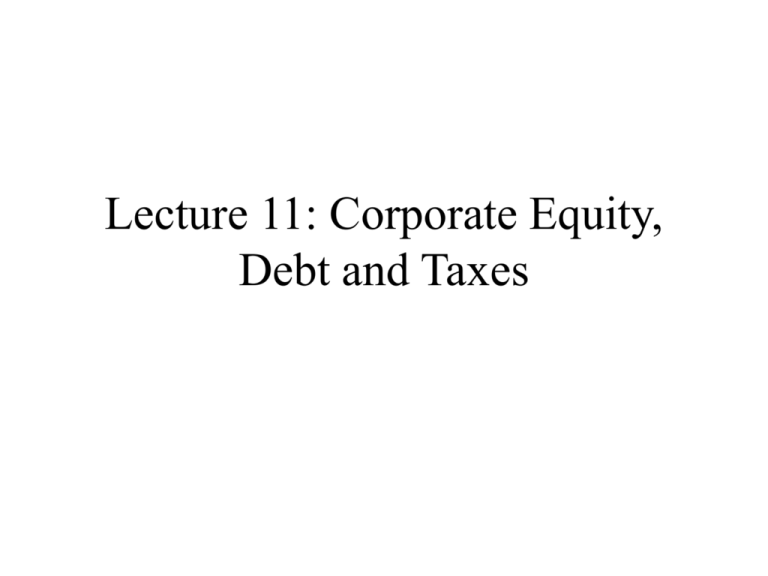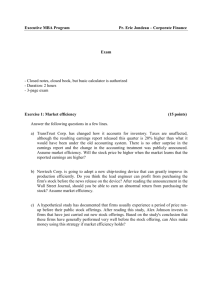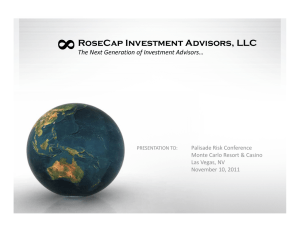Lecture 10: Corporate Equity, Debt and Taxes
advertisement

Lecture 11: Corporate Equity, Debt and Taxes Leverage • Corporate Leverage is measured by Debt D divided by equity E. • Highly levered firms court bankruptcy • Unlevered firms cannot go bankrupt (Microsoft owned $5.9 billion of other firms’ long-term debt and $23.8 billion in cash and short-term investments in 2000. Xerox Corporation Consolidated Balance Sheet 1999 (in millions) • Assets: – – – – – – Cash $126 Receivables $15940 Inventories $2961 Buildings & equipment $2456 Other $7331 Total $28814 Xerox Corporation Consolidated Balance Sheet 1999 Cont. • Liabilities – – – – – – – Short-term debt $3957 Long-term debt $10994 Deferred taxes $2263 Preferred stock $669 Other $6020 Shareholders equity $4911 Total $28814 Microsoft Balance Sheet 2000 (in $ millions) • Assets: – – – – – – Cash & equivalents $4846 Short-term investments $18952 Property & equipment $1611 Equity and debt investments $17726 Other $9015 Total assets $52150 Microsoft Balance Sheet 2000 in $Millions Continued. • Liabilities – – – – – – Income taxes $585 Accounts payable $1016 Unearned revenue $4816 Other $4065 Stockholders equity $41368 Total $52150 » No debt: no corporate bonds or bank loans! Comparing Market Caps • Xerox Market Capitalization = 667 million shares $6.95/share = $4.6 billion 2/11/01 (compare with shareholders equity = $4.9b.) • Microsoft Market Capitalization = 5.3 billion shares $59.13/share = $315.3b. (compare with stockholders equity=$41.4b) Expected Return on Assets • Expected return on assets = rA= weighted cost of capital = expected return on a portfolio consisting of all of a companies liabilities. rA D E rD rE DE DE D rE rA (rA rD ) E Value of Firm in Terms of rA • Suppose Dividends are constant =Div and debt is perpetual, paying Coupon C. • D=C/rD and E=Div/rE • Value of firm = V=D+E=C/rD+Div/rE • Value of firm = V = (C+Div)/rA • rA=weighted average cost of capital = (D/(D+E))rD+(E/(D+E))rE Firm’s Objective: Maximize Overall Market Value V • Present Value Model: V=(C+Div)/rA • Strategies: Increase C+Div, or lower rate of discount rA. Traditional Position (Before Modigliani-Miller) • Both rD and rE are not much affected by the ratio, probability of bankruptcy is so low that it is approximately zero. • Since rD<rE, so firms should borrow money and buy back shares to lower rA, thereby raising the value V of the firm. Modigliani-Miller • In absence of taxes, value of firm is independent of D/E. • D/E only affects division of income stream between C and Div, so one who buys all D and all E doesn’t care what D/E is. Hence, V is unaffected by D/E. Adding Taxes to M&M • Interest paid is deductible for corporate profits taxes, dividends paid are not. • Therefore, raising D/E raises numerator of V: firms can pay out more since their taxes are lower. • Conclusion: firms should make D=V? • Problem with that: if D/E=, the firm is bankrupt, and debt becomes equity. Bankruptcy Costs Limit D/E • If D/E gets too high, the probability of a bankruptcy gets too high. • Bankruptcies disrupt the operations of the firm. • Legal costs. • Conclusion: Each firm must judge how high it can push D/E against its risks and costs of bankruptcy. Recent Trends in Corporate Debt • Just as firms are paying less dividends to reduce taxes, they are also borrowing more. • Typical large firm in late 1990s purchased 2% of shares per year, issued 1%, so 1% net repurchase. • In first 11 months of 2000, firms issued $146 billion in equity, and $935 billion in corporate bond market • Debt is becoming riskier, more equity-like Other Motives for Issuing Corporate Debt • Management Incentive Options – Management shares in up side, but does not lose in down side • Management has an increasing incentive to pursue a high-risk strategy in recent years.








